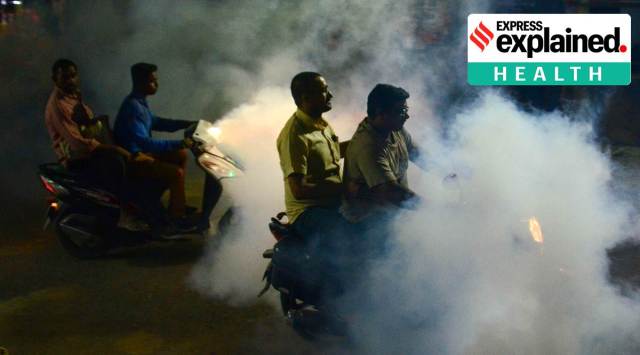- India
- International
An Expert Explains: What is needed to avert antimalarial drug resistance in India
The time has come to carry out Molecular Malaria Surveillance to find out the drug-resistant variants so that corrective measures can be undertaken in time to avert any consequences.
 Fogging in Ahmedabad as a measure against mosquito-borne diseases. (Express Archive)
Fogging in Ahmedabad as a measure against mosquito-borne diseases. (Express Archive)In most malaria-endemic countries including India, Artemisinin-based antimalarial drugs are the first-line choice for malaria treatment especially against Plasmodium falciparum parasite which is responsible for almost all malaria-related deaths in the world. In recent years there is increasing evidence for the failure of artemisinin-based combination therapy for falciparum malaria either alone or with partner drugs.
On September 23, the New England Journal of Medicine published an article `Evidence of Artemisinin-Resistant Malaria in Africa’. The study described the presence of two mutations responsible for artemisinin resistance in Northern Uganda. The current report of artemisinin resistance in East Africa is a matter of great concern as this is the only drug that has saved several lives across the globe.
In this report, investigators report the emergence of artemisinin-resistant Plasmodium falciparum strains of malaria in Northern Uganda. https://t.co/BXzXd0qOSP pic.twitter.com/apXYBBujPE
— NEJM (@NEJM) September 24, 2021
In India, after the failure of chloroquine to treat P. falciparum malaria successfully, artemisinin-based combination therapy was initially introduced in 117 districts that reported more than 90% falciparum burden in 2008.
In 2010, artesunate plus sulfadoxine-pyrimethamine (AS+SP) was introduced universally, but in 2013, in view of resistance to the partner drug SP in the seven North Eastern States, the combination partner was replaced by artemether-lumefantrine (AL) for these states.
Currently, several combinations of artemisinin derivatives are registered in India.
Artemisinin-based combination therapy failure in India
In 2019, a report from Eastern India indicated the presence of two mutations in P. falciparum cases treated with artemisinin that linked to its presence of resistance.

Again in 2021, artemisinin-based combination therapy failure was reported from Central India where the partner drug SP showed triple mutations with artemisinin wild type.
This means the failure of artemisinin-based combination therapy may not be solely linked to artemisinin. Here it is needed to change the partner drug as has been done in NE states in 2013.
In the past, chloroquine was very effective for all types of malaria treatment in India. But it is no longer used for the treatment of falciparum malaria.
Though there have been some reports of chloroquine resistance in P. vivax malaria, this drug is still the effective choice to treat this species.
Reports of the presence of chloroquine resistance mutations in some vivax-dominated areas are a cause of concern and continued monitoring is needed.
History of drug resistance
In the 1950s chloroquine resistance came to light. Both chloroquine and pyrimethamine resistance originated from Southeast Asia following their migration to India and then on to Africa with disastrous consequences.
Similarly, artemisinin resistance developed from the six Southeast Asian countries and migrated to other continents, as is reported in India and Africa. It would not be out of context that artemisinin is following the same path as has been seen with chloroquine.
Now, the time has come to carry out Molecular Malaria Surveillance to find out the drug-resistant variants so that corrective measures can be undertaken in time to avert any consequences. Some experts even advocate using triple artemisinin-based combination therapies where the partner drug is less effective.
The author is a former scientist G, National Institute of Malaria Research, ICMR, Bengaluru Field Unit.
More Explained
EXPRESS OPINION
Apr 25: Latest News
- 01
- 02
- 03
- 04
- 05










































